Observations (Clay, remoulded)
In the previous sections Triaxial Test and Observations (Sand), we explored the behavior of sands under various initial conditions and drainage scenarios. A natural question arises: do these observations hold true for other types of soils, such as fine-grained soils like clays? This section aims to shed light on this query by examining laboratory tests on remoulded fine-grained soils.
We choose to focus on reconstituted samples primarily due to two reasons. First, there is a scarcity of high-quality tests on undisturbed samples. Second, undisturbed samples often exhibit complex characteristics, like significant anisotropy (either induced or inherent), varying degrees of saturation, and other specific traits. Addressing these complexities would go beyond the scope of this introductory chapter on critical state soil mechanics.
To determine whether the insights gained from sand apply to fine-grained soils, we will delve into undrained triaxial compression tests conducted on three distinct fine-grained soils. These soils are represented in the Casagrande chart below and are identified as follows:
- Berghausen Schluff (marked with a red dot)
- Konstanzer Seeton (marked with a green dot)
- Kaolin (marked with a blue dot)
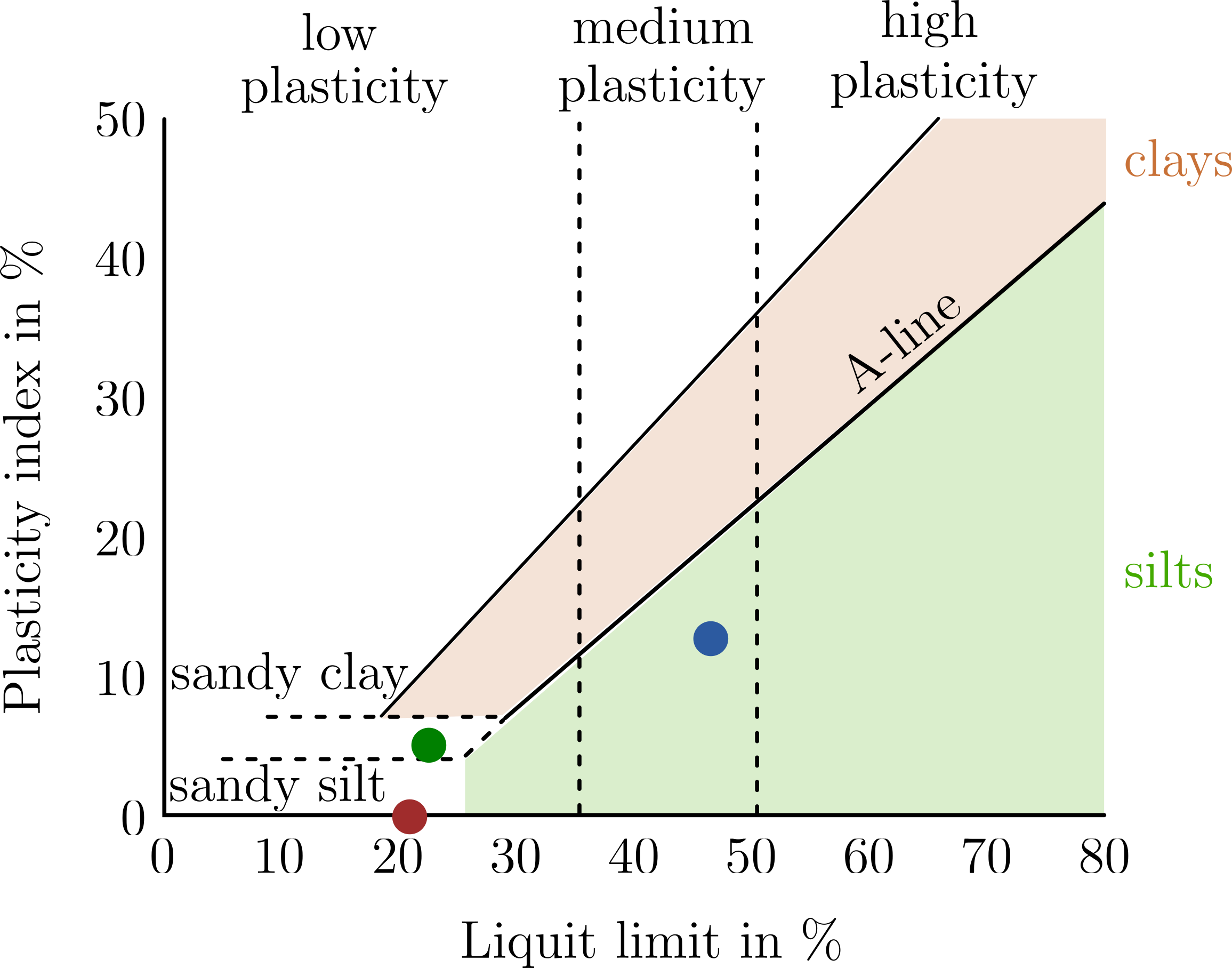
Berghausen Schluff
Berghausen Schluff has a plasticity index of 0 and is according to the Casagrande chart a silty sand. The results of four undrained triaxial compression tests performed on normally consolidated samples are summarized in below figure. It can be observed that both the development of the deviatoric stress \(q\) with the axial strain \(\varepsilon_1\) and the stress path in the \(p^\prime-q\) diagram are similar to the behaviour of sand. The linear relationship between \(q\) and \(p^\prime\) at failure is clearly visible.
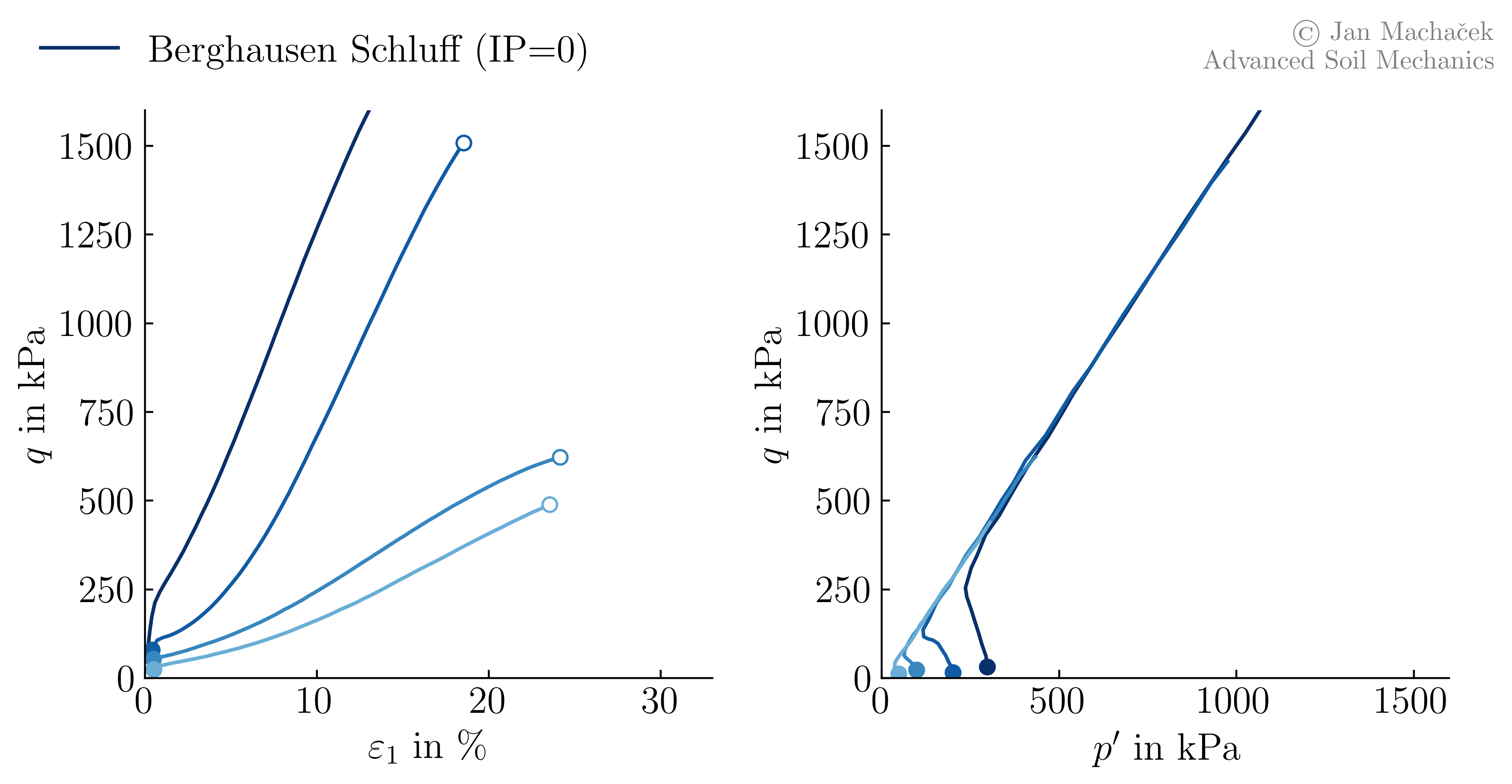
Konstanzer Seeton
The second material, the Konstanzer Seeton, is - contrary to what its name suggests - located in the Casagrande chart in the intermediate area between sandy clay and sandy silt and has a plasticity index of 5.3 %. Compared to the Berhausen Schluff, the behaviour is less dilative
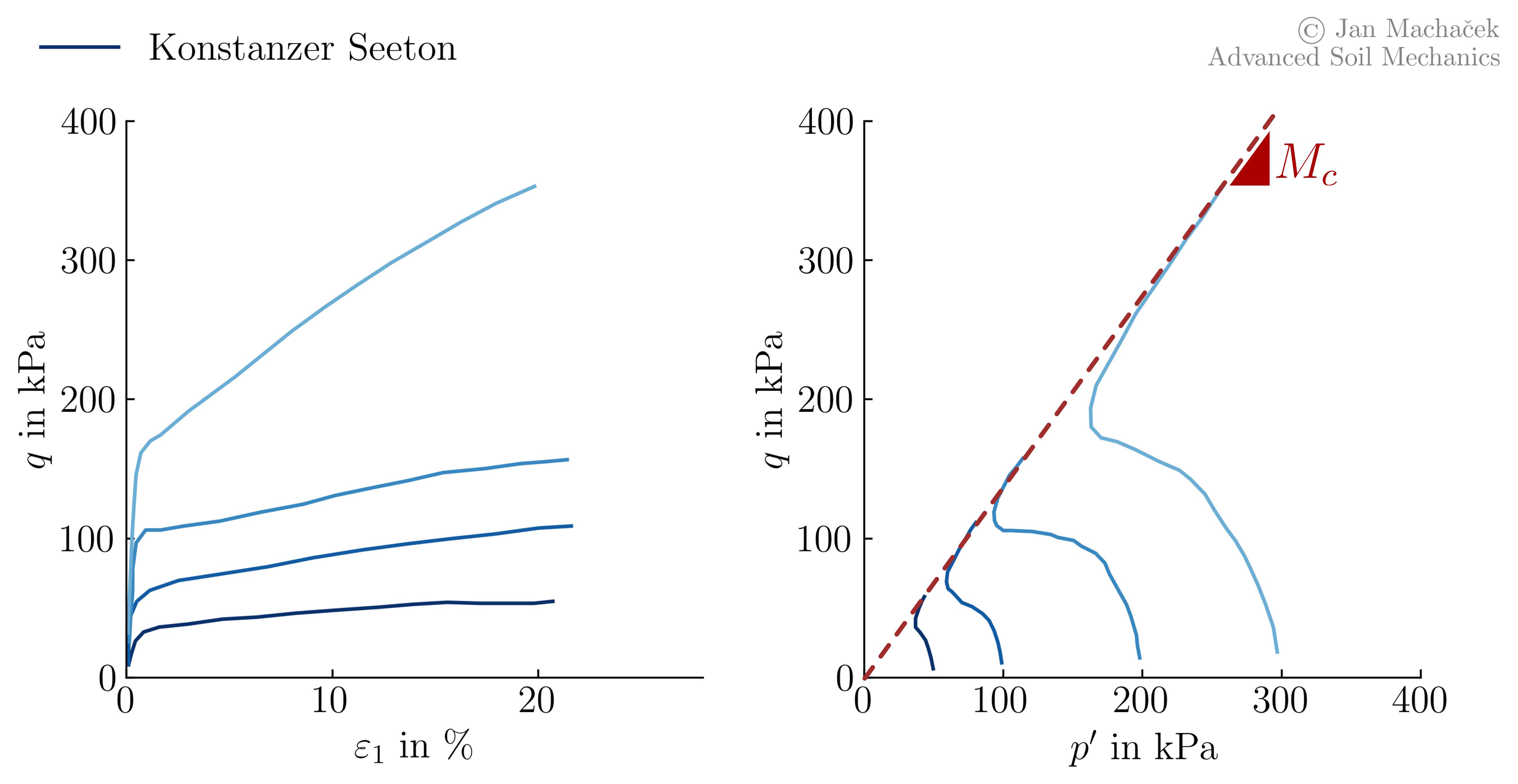
Compared to the Berghausen Schluff, the Konstanzer Seeton shows less dilatant behaviour. This can be seen, for example, in the \(p^\prime-q\) diagram by the significant decrease in mean effective pressure \(p^\prime\) in the early part of the test. However, as the shear strain increases, the behaviour of the material becomes more dilatant, leading to an increase in the deviator stress. The stress ratios at failure can again be described by a linear relationship with the slope \(M_c\), as shown in the corresponding figure.
Kaolin
The experimental campaign on Kaolin is documented in 1 and the data is freely available from Prof. Wichtmann. The experimental campaign included undrained monotonic triaxial tests on samples of remoulded kaolin with variation of the initial mean effective pressure, the over consolidation ratio OCR and the strain rate at which the samples are sheared. The Kaolin used in this study has a plasticity index of 12.2 % and is a medium plastic silt according to the Casagrande chart.
Influence of the initial mean effective pressure
The influence of the initial mean effective pressure \(p^\prime_0\) on the shear behaviour of kaolin was investigated on five normally consolidated samples with different \(p^\prime_0\). The results of this series of tests are shown below.
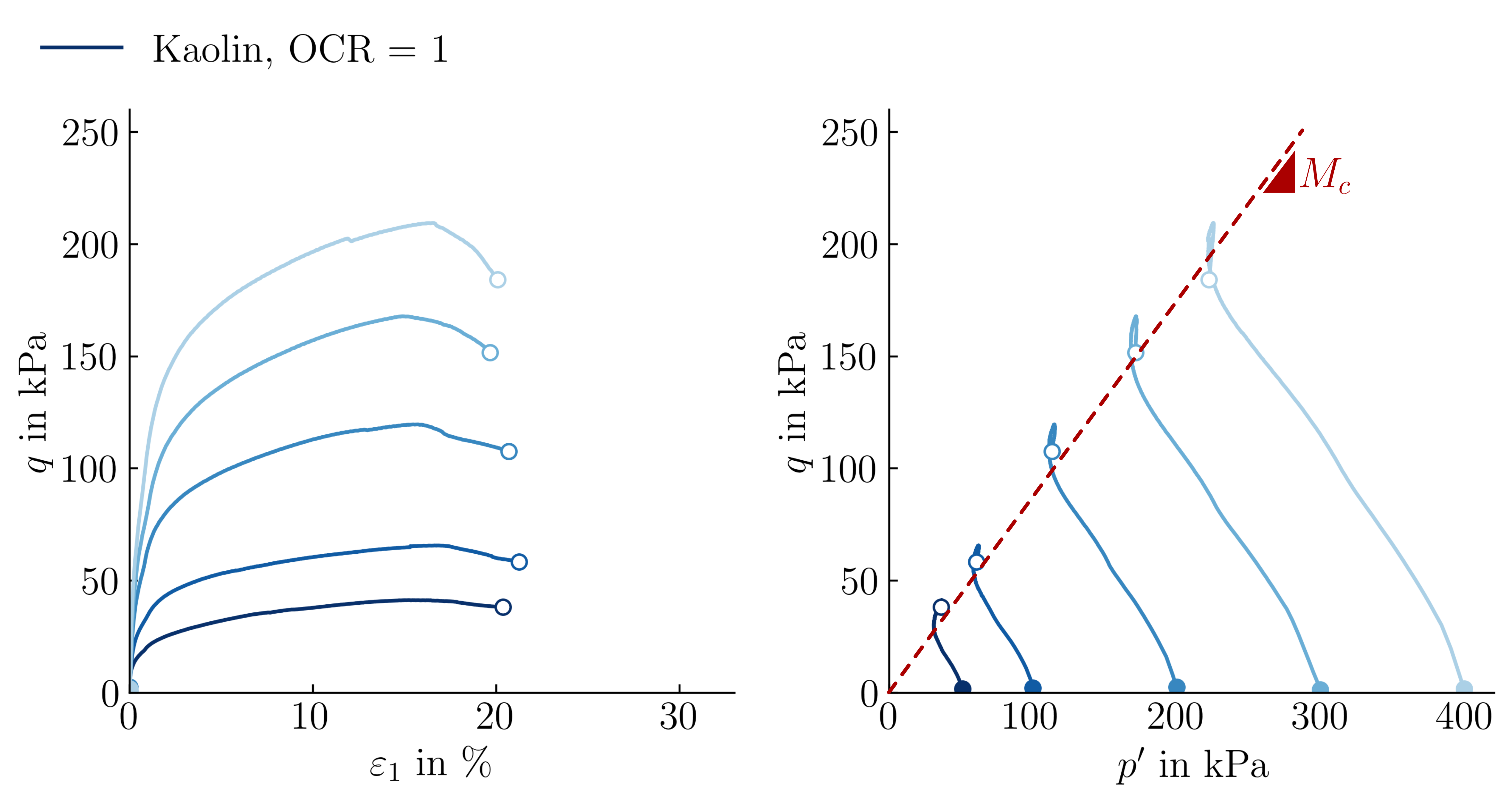
It can be clearly seen that the observed material behaviour is significantly influenced by the tendency to contract (see decrease in mean effective pressure \(p^\prime\) in the \(p^\prime-q\) diagram). Tendencies towards dilatant behaviour are only observed close to failure. In contrast to the Lake Berghausener Schluff and the Konstanzer Seeton, stress states above the failure line (i.e. stress ratios greater than \(M_c\)) are first observed before falling back to the failure line.
Influence of preloading
The influence of the preloading on the shear behaviour of kaolin was investigated on three additional samples with different overconsolidation ratios OCR\(=p^\prime_{max}/p^\prime_0\). The results of this series of tests are shown below.

We observe that the higher OCR, the lower is the void ratio \(e_0\) at \(p^\prime_0\) prior to the undrained monotonic shearing. Consequently, with increasing OCR the material response is rendered more dilative and higher deviatoric stresses, i.e. larger undrained monotonic strengths are reached. The effective stress paths measured for the higher OCR values are bounded by the failure envelope encountered in the monotonic tests on normally consolidated samples. The observed increase in shear strength is similar to the increase in shear strength with increasing initial density observed for sand.
Influence of loading rate
The rate dependence of the Kaolin is investigated by three additional tests with different strain rates (or displacement rates \(\dot{s}\)). The result of this series are given in the figure below. It can be seen that with increasing strain rate (higher \(\dot{s}\)) the material response renders slightly less contractive and the undrained shear strength moderately increases. Stronger strain rate effects are expected for materials with higher plasticity.
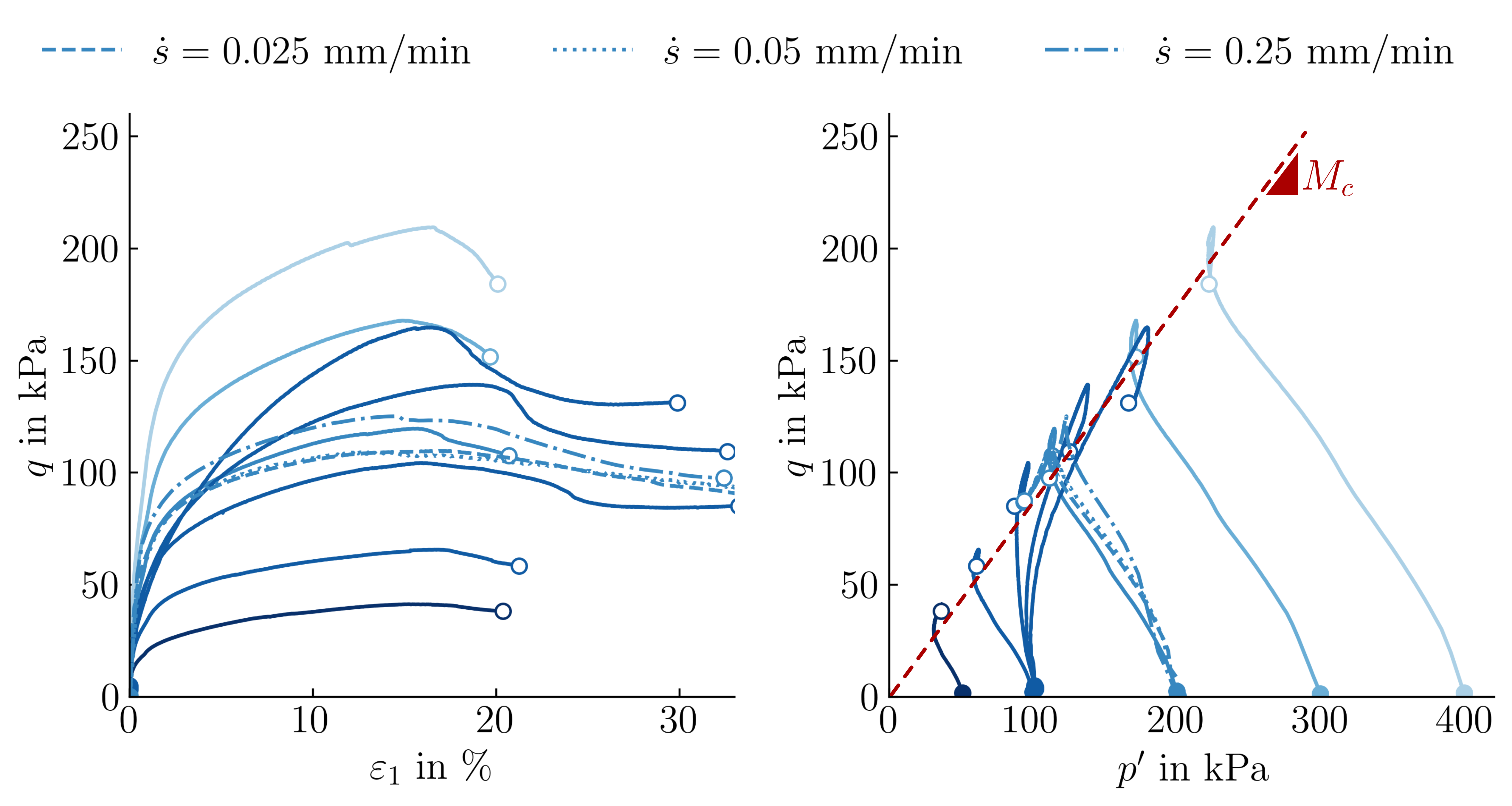
Conclusion
Undrained triaxial tests on three different fine-grained soils of different plasticity were used to confirm our observations for sand: For high shear strains, the stress paths in \(p^\prime-q\) space converge to a common line, known as the failure line.
-
T. Wichtmann and T. Triantafyllidis, ‘Monotonic and cyclic tests on kaolin: a database for the development, calibration and verification of constitutive models for cohesive soils with focus to cyclic loading’, Acta Geotech., vol. 13, no. 5, pp. 1103–1128, Oct. 2018, doi: 10.1007/s11440-017-0588-3. ↩